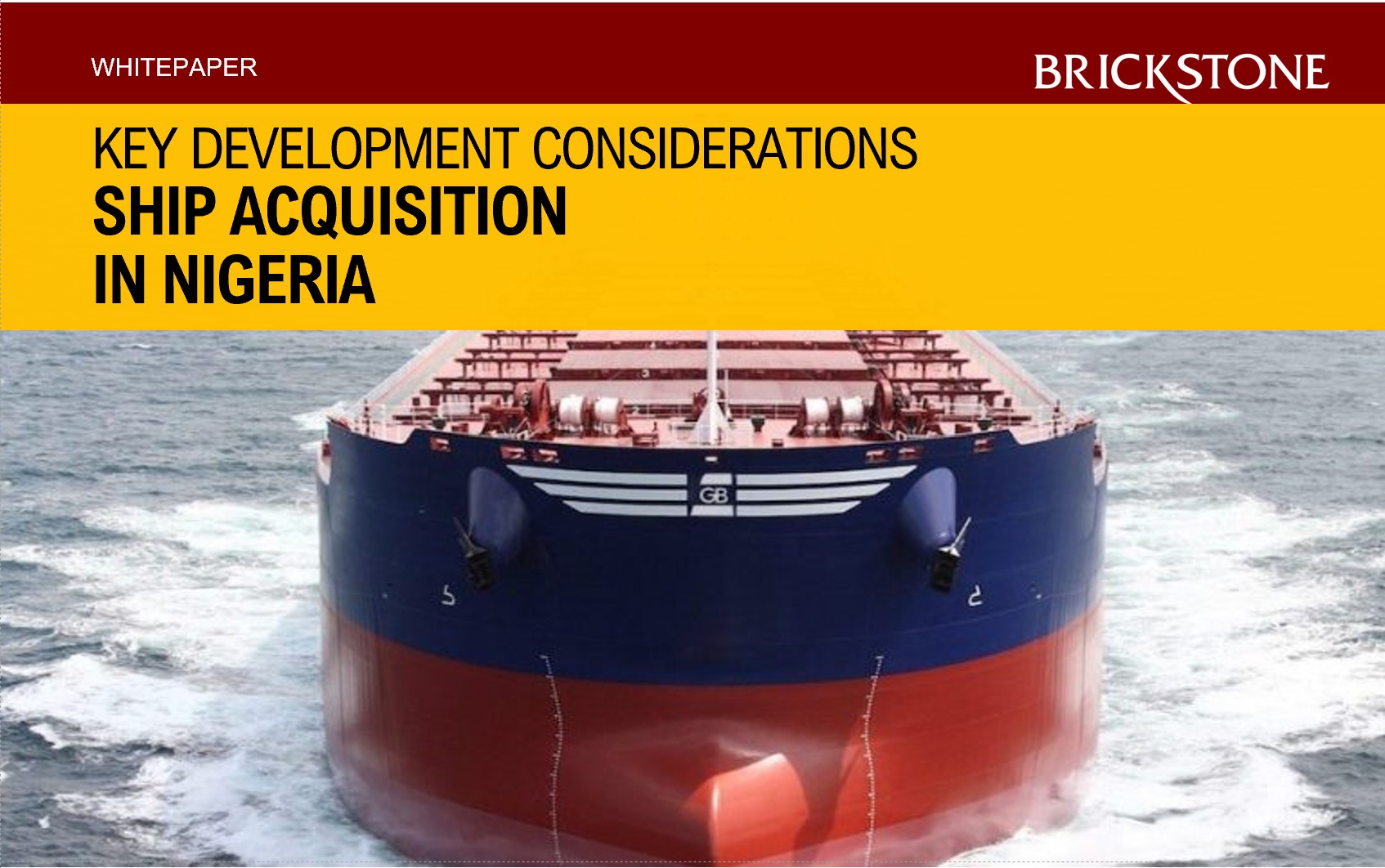Key Development Considerations: Ship Acquisition in Nigeria
Ship Acquisition in Nigeria
Ship Acquisition in Nigeria has been faced with many challenges in recent times, especially with the decline in capital raising. Nonetheless, it can still be done in various innovative ways, which are more easily accessible, and suitable for the long-term nature of the Shipping Industry.
This White Paper has been curated by the expert team at Brickstone Africa for stakeholders in the Shipping Industry, with the purpose of addressing key issues that are deserving of attention when contemplating making a ship acquisition in Nigeria.
It starts by exploring the process of acquiring ships through ship finance. It first points out that ship finance entails the funding of activities relating to ships and shipping (the ownership and/or operation of ships) where the ship is a central figure, both as the ‘object’ (directly or indirectly) of the finance transaction and, very frequently, as the principal or one of the main items of security in the transaction.
The White Paper further explains that these ship finance transactions involve a lender providing funding to a borrower for the purchase of a vessel, or to refinance existing indebtedness already in place in respect of a vessel. Usually, the lender looks to put itself in the best possible position both in respect of the initial security position following the provision of finance, as well as in the subsequent operation of the vessel.
In addition to the foregoing, this White Paper mentions various sources of ship finance, some of which includes funding from owners’ own funds, institutional financiers, capital markets, investment funds, etc. Also, this White Paper gives a brief overview of three forms of ship finance, and their goals in transactions. They include Asset Finance, Corporate Finance, and Equity Finance.
The main purpose of Asset Finance is the acquisition or operation of one or more assets. The asset in this context being a ship. The major goal of Corporate Finance is to inject liquidity into the borrower or the wider group of companies to which the borrower belongs in an attempt (albeit indirectly) to strengthen the borrower’s balance sheet. Lastly, with regards to Equity Finance, ordinary equity which includes voting rights, rights to dividends, rights to appoint directors, amongst others are used to finance ship acquisition.
Moving forward, this White Paper gives an extensive exposition into the Key Legal Framework with respect to financing and ship acquisition in Nigeria. It explains the provisions of important statutes including, The Nigerian Maritime Administration and Safety Agency (NIMASA) Act 2007; The Coastal and Inland Shipping (Cabotage) Act 2003; The Merchant Shipping Act, 2007; and The Value Added Tax Act, 1993.
This White Paper further considers in great detail, the intricacies of Ship Acquisition by Asset Finance. It states that the traditional model for ship finance transactions has often been in the form of asset finance, which is usually provided by institutional financiers. It also mentions that ship acquisition in Nigeria through asset finance can take three forms, one of which is the acquisition of tonnage (new or second-hand) secured by real security over the ship which is the focus of the ship acquisition and finance. Others are explained comprehensively in the White Paper.
Additionally, the risks that a lender in a ship finance would consider in assessing whether or not to grant a facility are also explored in this White Paper. Some of those risks to be considered include: Credit Default Risk, Market/Structural Risk, Risk of Assessment, Risk of Loss of the Secured Assets, and so on.
Furthermore, this White Paper mentions the securities that are required in a typical ship acquisition and finance transactions, and some of them includes thus: Guarantees, Mortgages; Assignment of earnings; Assignment of rights under contracts of insurance; Pledges or other charges over shares/securities; and Pledges or other charges of earnings accounts.
This White Paper also addresses the key issues in documentation for ship acquisition and finance, and some of these issues consists of Negotiation of the term sheet; Creation of the Facility Agreement; Payment of the necessary interest, usually based on LIBOR and interest periods; Repayment and Prepayments; Insurance Undertakings; Environmental Undertakings; Regulatory restrictions imposed upon the lender, etc.
Moving Forward, this White Paper thoroughly discusses various other matters which arise in ship acquisition and finance. One of the matters discussed is the Operation of the Vessel. Naturally, the lender will be concerned about the protection of its position in respect to the operation of the vessel, the earning capacity of the vessel, and repayment of the loan. As a result, there will be in place, a charter-party which is an agreement concerning the use or employment of a vessel, or some part of it, for a voyage or series of voyages for a specified time. The main types of charter are Voyage Charter, Time Charter, and Bareboat Charters. These charters are explained fully in this White Paper.
Ships can be acquired in many different ways or combination of ways. This White Paper gives an in-depth address of the ways by which vessels, whether new or existing, can be acquired. First, it explains how ships can be acquired by a prospective buyer who can place an order with the shipyard for the construction of a specific type and size of vessel. For new ships, the contract for ship building is expressed on Standard Forms. However, for existing vessels, the parties express their agreement in a Memorandum of Association. This method of acquisition is explained in great detail in this White Paper.
This White Paper goes further to explain the meaning of a Ship Building Contract, as well as the obligations of the builder and buyer. It also considers Allocation of Risks in such contracts between the parties.
It must be noted that the processes involved in the acquisition of an existing vessel are somewhat different from that of building a new ship. In the case of an existing ship, the contract of sale or purchase is usually negotiated by ship brokers acting as agents of both the buyer and the seller. After negotiation, agreed terms are written down in a Norwegian Shipbrokers Association Memorandum of Agreement for Sale and Purchase of Ships. Other stages of the transaction including Pre-Delivery, Delivery, and Post-Delivery have been explored thoroughly in this White Paper.
Conclusively, this White Paper considers other options for Ship Acquisition and Financing, different from those already addressed. These options include raising capital from the Debt Market and Private Equity Funds. The key issues and challenges surrounding investment through these sources that must be at the centre of any decision maker’s table have also been explored in this White Paper.
[mailerlite_form form_id=26]
OTHER E-BOOKS THAT MAY BE OF INTEREST
Developing Information Memorandum for Large Projects
Template for Strategic Business Plan
Template for Feasibility Studies for Large Scale Projects
Why not contact us to make your Project Happen
Our advisors and consultants would be able to schedule an online meeting with you to discuss your project with the overall objective of seeking ways to achieve the “bankability” and protection of the long term asset value of your project. Request a Meeting Now








